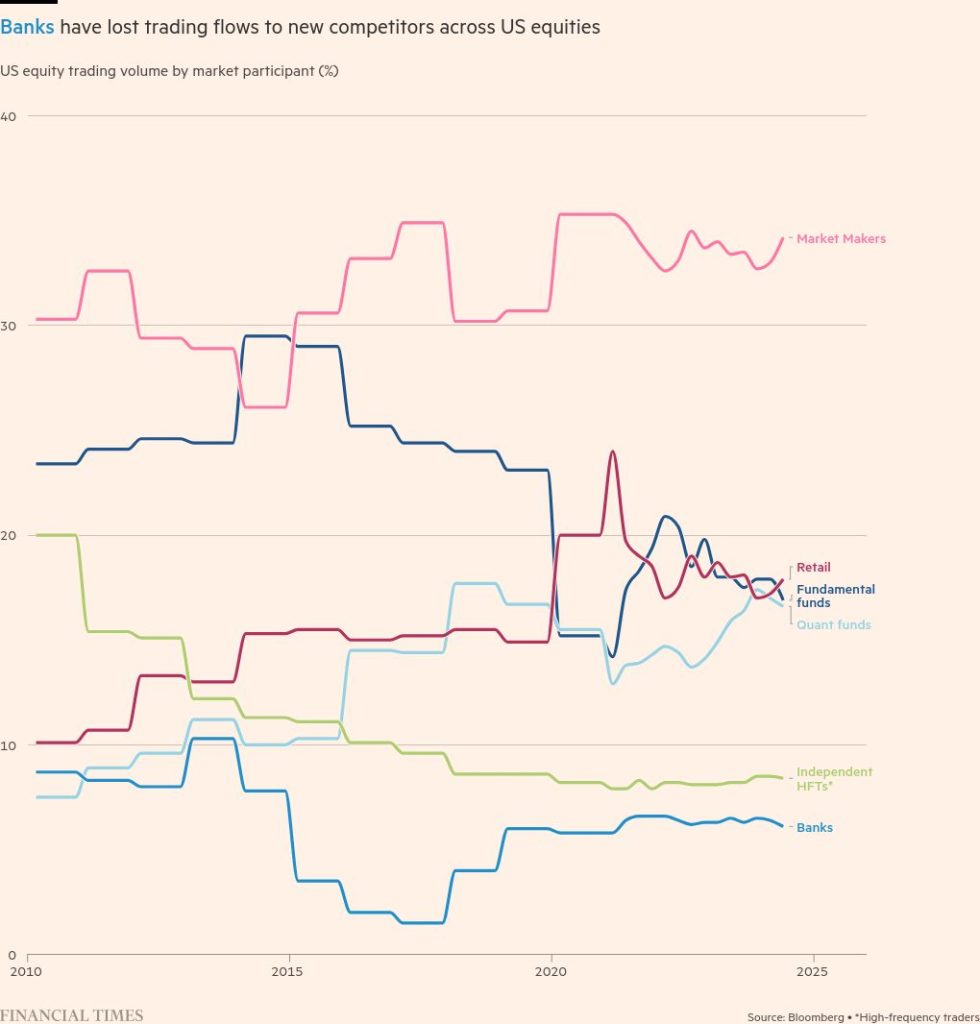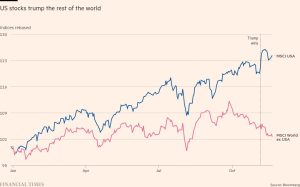The new titans of Wall Street

Unlock the Editor’s Digest for free
Roula Khalaf, Editor of the FT, selects her favourite stories in this weekly newsletter.
Trillions of dollars of financial securities change hands every day. A few decades back, exchanges took place in raucous trading pits where dealers would bellow out prices to match buyers and sellers. Then the banks went electronic. Today, the task of market-making has evolved into a competitive and highly lucrative computerised sport beyond the banking sector, where wits, speed and technology are helping players gain an edge. And as the Financial Times’ New titans of Wall Street series has outlined, a handful of innovators have mastered it, leaving the biggest names in banking in the dust.
Independent trading firms, including Citadel Securities, Jane Street, Susquehanna International Group, XTX Markets and DRW, have taken advantage of electronic transactions and algorithms to trade and make markets in an array of assets at mind-boggling speeds. These high-frequency traders have grabbed market share from less nimble investment banks, which prioritised big money deals over low-margin trades. For measure, Citadel Securities handles almost a quarter of all US stock trades. Last year, Jane Street traded options with a notional value of $32tn.
Many of the upstarts were founded around the turn of the millennium by seasoned dealers, and grew to prominence in the aftermath of the financial crisis. They are eclectic, secretive — and minted. Jane Street’s love of puzzles led to a specialisation in complex assets like exchange traded funds. Susquehanna has built a niche in options, and XTX has conquered foreign exchange, in part by using machine learning to scan trillions of market data points. Citadel Securities’ business model focuses on combing data from order flow to make its prices more competitive, while DRW’s revenue comes predominantly from directional bets, rather than market-making.
Their unique algorithms and trading strategies are designed by sophisticated coders, mathematicians and engineers, who are in turn rewarded with handsome salaries. The annual base salary (excluding bonuses) for interns at Jane Street can exceed that of the US Federal Reserve chair and the British prime minister.
The firms’ success is proof of the benefits of creative destruction. As Wall Street’s largest lenders prioritised big money quotes, and were hemmed in by post-financial crisis regulatory requirements, these traders stepped into the low-margin, high-volume trading game with technological innovation. Investing is now significantly cheaper; the big banks often charged hefty transaction fees. Global liquidity across assets is also now more abundant, helping to bolster retail and wholesale capital markets. The added competition pushes banks to innovate and invest in technology, too.
Some analysts reckon the new masters of trading are also better stewards of the market than banks. As privately owned firms, losses are felt by founders and employees, driving a culture of caution. For instance, Jane Street says it maintains an extra “liquidity buffer” of about 15 per cent of its trading capital, to help it hold on to positions even in chaotic markets.
But as trading firms grow, so does their significance to the financial system. The 2010 “flash crash” in US equities and 2014 “flash rally” in Treasuries — which were exacerbated by high-frequency trading — underscored the risks of more money flowing through opaque and less-regulated non-bank financial institutions. Since then there have been myriad lower-key, but still unnerving, glitches.
If the new breed of traders’ algorithms trips up, market confidence and liquidity will suffer. Today, banks and non-bank trading firms operate in an ever more complex web where they are often clients, counterparties, and competitors. Better monitoring of Wall Street’s new titans is now both logical, and essential.
#titans #Wall #Street





